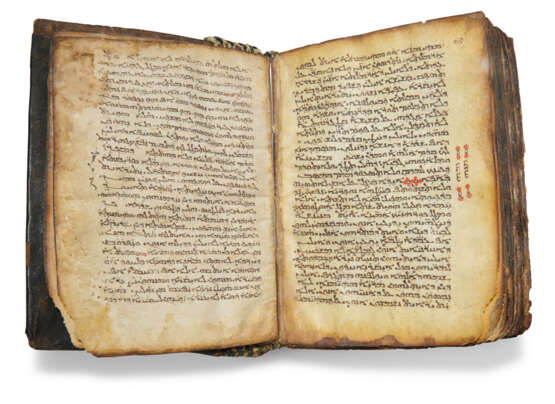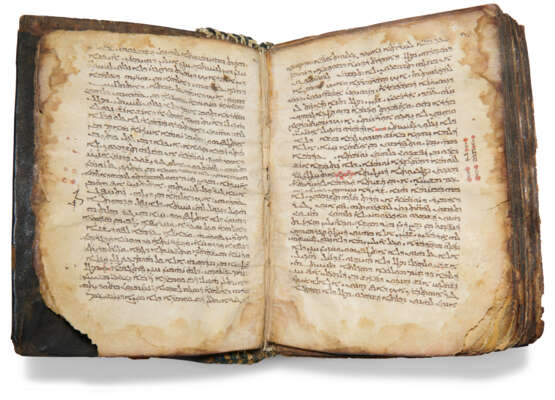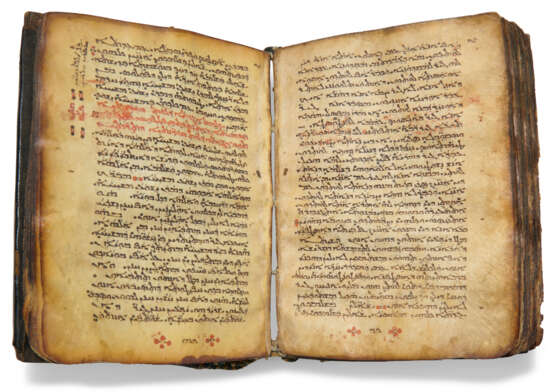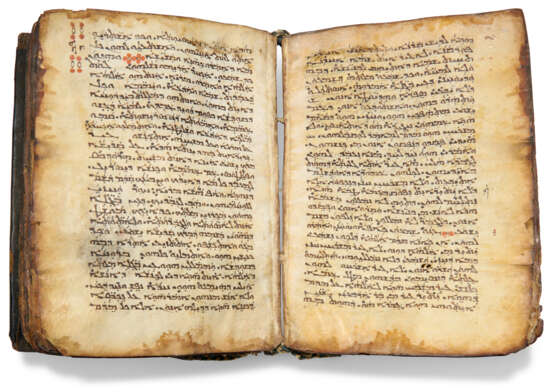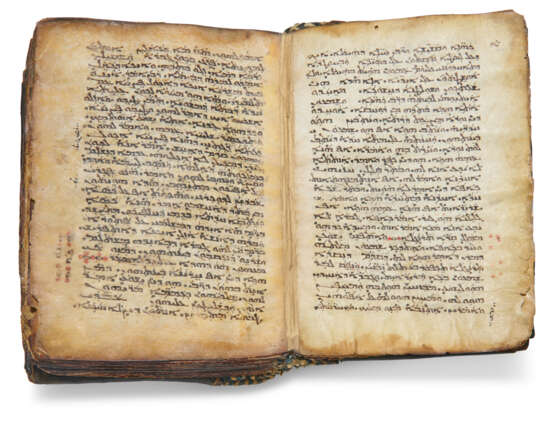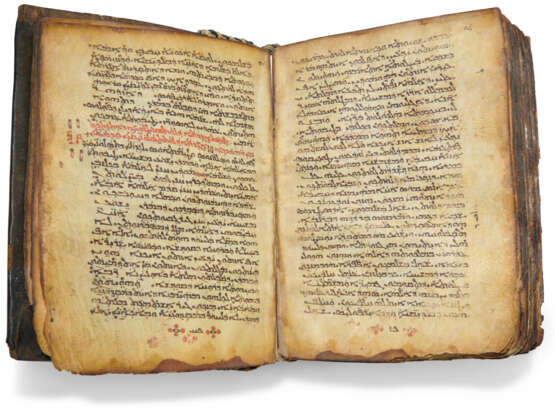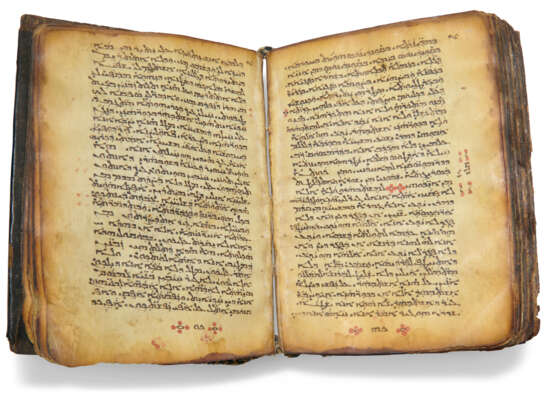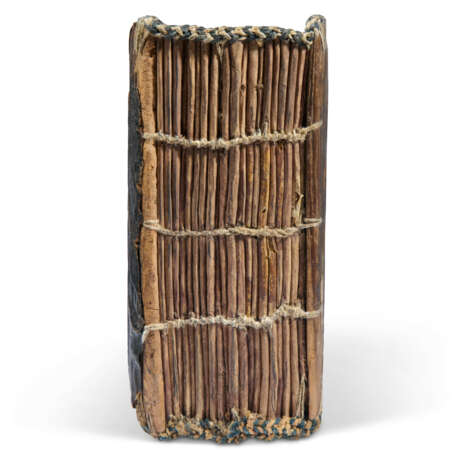ID 1214871
Lot 5 | Syriac New Testament
Estimate value
£ 150 000 – 200 000
Peshitta New Testament, in Syriac, decorated manuscript on vellum [Eastern Syria, late 9th to 10th century]
A substantial survival of a 9th/10th century Syriac Peshitta New Testament, probably the oldest and most extensive in private hands, in an early medieval binding.
248 x 182mm. 187 leaves, collation: 16, 28, 39, 4-910, 1012, 11-128, 1312, 148, 1512, 16-178, 1812, 19-208, originally 30 numbered gatherings of which 20 survive, modern foliation in pencil followed here, single column of 28-29 lines written in a very fine and regular East Syriac estrangelo, fairly fully vocalised, punctuated, and accented, written space: 205 x 125mm, contemporary marginal notes of a masoretic nature in a cursive hand, superscriptions to books and major punctuation in red, added after the gatherings had been put together, gathering numbers provided in centre of lower margins of the first and 10th leaf of each gathering (lacking 9 gatherings at the beginning and 25 other mostly isolated leaves, edges stained and darkened throughout, some cockling, opening leaves frayed and defective, but otherwise well-preserved and in good condition).
Binding:
Early medieval, perhaps original, wooden boards with remains of dark brown calf, blind-stamped with double-ruled diamond pattern, without spine, revealing stitching, green and white knotted endbands (surviving calf a little warped, boards a little cracked). In a fitted box.
Provenance:
(1) The manuscript was produced in the area which is now Eastern Syria and Northern Iraq, and was probably taken to Georgia by one of several groups of Syriac Christians who migrated there in the middle ages.
(2) Sam Fogg, acquired in 1995 by:
(3) The Schøyen Collection, MS 2080.
Contents:
Peshitta New Testament, with the Gospels of Luke, John, Acts and the Epistles, opening on f.1 with Luke 14:27 and ending on f.187v with Heb.13:13 (lacking Matthew 1:1-Luke 14:7; Luke 18:8-22:9; Luke 23:49-John 2:1; John 19:6-20:9; Acts 27:2-27:21; Acts 27:43-28:20; 1 Peter 1:24-2:20; 1 Timothy 6:2-2 Timothy 2:9; Hebrews 5:12-9:6; and Hebrews 13:14-13:25). The Peshitta New Testament ends at with Hebrews and does not include the Revelations of John, which is not canonical in Eastern Churches.
The Peshitta ('simple', 'common', 'straight', or 'vulgate') is the standard version of the Bible for churches in the Syriac tradition. General academic consensus maintains that the Old Testament was translated into Syriac from Biblical Hebrew at some point in the 2nd century, and that the New Testament was translated from Koine Greek, probably in the early 5th century. This New Testament originally excluded certain disputed or non-canonical books (namely 2 Peter, 2 John, 3 John, Jude, Revelations, as in the present manuscript). The New Testament of the Peshitta often reflects the Byzantine text-type, although with some variations. The oldest extant text is dated by colophon to 534 (British Library, Add MS 14459). There are some 50 extant Peshitta manuscripts dating from the 6th to the 10th centuries, all in public institutions, which likely makes the present manuscript the oldest Syriac New Testament in private hands.
An earlier cataloguer noted how the present manuscript 'is comparable in every way with the famous Yonan Codex, sold at Sotheby's on 24th June 1986, lot 129, one of a class of manuscripts which were once thought to be of the seventh or eighth century but which are now usually considered to be of the ninth, tenth, or possibly eleventh century. It is noteworthy that even the pattern of stamping on the covers is of the same kind as found on the Yonan Codex'.
Shahe (Syriac chapter) numbers are given in two series: continuously throughout the New Testament, [1]-165; and a separate sequence for each Gospel (Luke [1]-[23], John [1]-20); Acts and Catholic Epistles; and the Pauline Epistles (1-55). For Acts and the Catholic Epistles the manuscript provides for two systems: the first originally numbered these together (1-32); thus the beginning of James = shaha 26, and this continues to the end of 1 Peter; 1 John, however, is not numbered 31, as the first sequence would require, but 6, which implies that the Catholic Epistles were also sometimes given a separate sequence, with James beginning again at 1.
The marginal notes mostly specify matters of accentuation and correct pronunciation, but there are also a small number of exegetical notes, sometimes in a slightly later hand: for example Nicodemus (John 3:1) is identified as 'the father of Stephan the martyr who was stoned'; at the end of 1 Corinthians a later hand has added 'peth (game) [=stichoi]:1022'.
| Place of origin: | Asia, Syria |
|---|---|
| Auction house category: | Books and manuscripts |
| Place of origin: | Asia, Syria |
|---|---|
| Auction house category: | Books and manuscripts |
| Address of auction |
CHRISTIE'S 8 King Street, St. James's SW1Y 6QT London United Kingdom | |
|---|---|---|
| Preview |
| |
| Phone | +44 (0)20 7839 9060 | |
| Buyer Premium | see on Website | |
| Conditions of purchase | Conditions of purchase |
